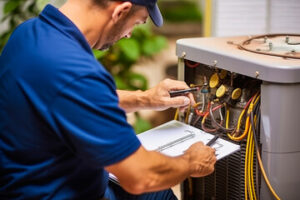Air conditioning systems play a crucial role in maintaining comfort and a stable indoor environment, especially during extreme weather conditions. When an air conditioning unit breaks down or malfunctions, it can lead to discomfort, inconvenience, and even health risks for the occupants of a home or building.

Understanding the process of AC repair, the common issues that arise, and how to maintain an AC system properly can help homeowners and property managers avoid costly repairs and prolong the lifespan of the unit. Repairing an AC unit requires technical knowledge, proper tools, and an understanding of how the system functions. It is not uncommon for an AC to exhibit signs of trouble, such as weak airflow, unusual noises, unpleasant odors, or inconsistent cooling. Contact AC Repair Round Rock for professional help.
These symptoms can be the result of various underlying issues, including clogged filters, refrigerant leaks, compressor failure, or electrical malfunctions. Promptly identifying and addressing these problems can prevent further damage and improve the overall performance of the system.
One of the most common problems with air conditioning systems is reduced airflow. This can be caused by dirty or clogged air filters, which restrict the flow of air and force the system to work harder to cool the space. Over time, this increased strain can lead to overheating, reduced efficiency, and higher energy bills. Regularly replacing or cleaning the air filters can help maintain proper airflow and prevent damage to the unit. Another potential cause of weak airflow is a malfunctioning blower motor. The blower motor is responsible for circulating cooled air throughout the building, and when it fails, the system may struggle to distribute air evenly. In such cases, repairing or replacing the blower motor is necessary to restore proper airflow.
Refrigerant leaks are another common issue that can affect the performance of an AC system. Refrigerant is the substance that absorbs heat from the indoor air and releases it outside, allowing the system to cool the air effectively. If there is a leak in the refrigerant lines, the system may struggle to cool the space adequately, and the compressor may overheat as it works harder to compensate for the loss of refrigerant. Repairing a refrigerant leak requires locating the source of the leak, sealing it, and recharging the system with the correct amount of refrigerant. Improper handling of refrigerant can be hazardous, so it is important for trained professionals to carry out this type of repair.
Electrical issues are another source of AC problems. Faulty wiring, damaged capacitors, and malfunctioning control boards can prevent the system from starting or cause it to shut down unexpectedly. Diagnosing electrical issues requires specialized knowledge and equipment, as well as an understanding of the system’s wiring diagram. A common electrical problem is a failed capacitor, which is responsible for starting the compressor and the fan motors. When a capacitor fails, the system may emit a humming sound or fail to start altogether. Replacing the capacitor is often a straightforward repair, but it requires proper handling to avoid electrical shock.
Frozen evaporator coils are another issue that can affect the performance of an AC unit. The evaporator coils are responsible for absorbing heat from the indoor air, and when they become covered in ice, the system cannot effectively cool the air. This problem is often caused by restricted airflow due to clogged filters, blocked vents, or a malfunctioning blower motor. In some cases, low refrigerant levels can also cause the evaporator coils to freeze. Resolving this issue involves thawing the coils, addressing the underlying cause of the restricted airflow, and ensuring that the refrigerant levels are within the manufacturer’s specifications.
Unusual noises coming from the AC unit can indicate mechanical problems that require immediate attention. A grinding or squealing sound may suggest a problem with the fan motor or the compressor. A rattling noise could indicate loose components or debris trapped in the system. Ignoring these noises can lead to more serious damage and costly repairs. Diagnosing the source of the noise and addressing it promptly can prevent further damage and restore the system’s performance.
Water leaks are another common problem with AC systems. An AC unit produces condensation as it cools the air, and this moisture is typically drained away through a condensate drain line. If the drain line becomes clogged or the drain pan becomes damaged, water can back up and leak from the unit. This can cause water damage to the surrounding area and create a breeding ground for mold and mildew. Clearing the drain line and replacing a damaged drain pan can resolve this issue and prevent further leaks.
The compressor is one of the most critical components of an AC system, and when it fails, the entire system may stop working. The compressor is responsible for pressurizing the refrigerant and circulating it through the system. If the compressor becomes damaged due to overheating, electrical issues, or refrigerant problems, it may need to be repaired or replaced. Replacing a compressor is a complex and costly repair, so it is important to maintain the system properly to avoid compressor failure.
Preventive maintenance is key to avoiding many common AC problems and ensuring the system operates efficiently. Regular maintenance includes cleaning or replacing air filters, checking refrigerant levels, inspecting electrical components, and ensuring that the system is free from obstructions. Scheduling an annual inspection by a qualified technician can help identify potential issues before they become major problems and keep the system running at peak performance.
Cleaning the condenser coils is another important maintenance task. The condenser coils are located in the outdoor unit and are responsible for releasing heat absorbed from the indoor air. Over time, the coils can become covered in dirt, leaves, and debris, which reduces their ability to dissipate heat. Cleaning the coils with a soft brush or a commercial coil cleaner can improve the system’s efficiency and prevent overheating.
Checking the thermostat settings and ensuring that the thermostat is functioning properly can also improve the performance of an AC system. A malfunctioning thermostat can cause the system to cycle on and off too frequently or fail to maintain the desired temperature. Replacing the thermostat or recalibrating it can resolve these issues and ensure that the system operates efficiently.
Air ducts play a vital role in distributing cooled air throughout the building. Leaks or damage in the ductwork can lead to energy loss and reduced cooling efficiency. Inspecting the ductwork for leaks and sealing any gaps with duct tape or mastic sealant can improve airflow and reduce energy costs. In some cases, professional duct cleaning may be necessary to remove dust, mold, and other contaminants that can restrict airflow and affect indoor air quality.
Humidity control is another important factor in maintaining a comfortable indoor environment. High humidity levels can make a space feel warmer and promote the growth of mold and mildew. An AC system that is not properly sized or maintained may struggle to remove excess humidity from the air. Installing a dehumidifier or adjusting the system’s settings can help regulate humidity levels and improve comfort.
Advances in technology have introduced smart AC systems that allow homeowners to monitor and control their systems remotely. Smart thermostats and mobile apps provide real-time data on energy usage and system performance, allowing homeowners to adjust settings and receive alerts about potential issues. These systems can also learn user preferences and adjust settings automatically to maximize efficiency and comfort.
Replacing an aging or inefficient AC unit with a modern, energy-efficient model can provide long-term savings on energy bills and improve indoor comfort. Modern AC units are designed to operate more quietly, use less energy, and provide better humidity control than older models. When considering a replacement, it is important to choose a unit that is properly sized for the space and installed by a qualified technician. An undersized unit will struggle to cool the space, while an oversized unit will cycle on and off too frequently, leading to higher energy costs and reduced lifespan.
Environmental factors such as heat, humidity, and exposure to pollutants can affect the performance and lifespan of an AC system. Installing the outdoor unit in a shaded area and protecting it from debris and weather damage can improve its efficiency and extend its lifespan. Ensuring that the system is properly insulated and sealed can also reduce energy loss and improve performance.
AC repair requires a combination of technical knowledge, proper tools, and experience. Attempting to repair an AC unit without the necessary expertise can lead to further damage and safety risks. Professional technicians have the training and equipment needed to diagnose and repair complex issues, ensuring that the system operates efficiently and safely. Homeowners who invest in regular maintenance and timely repairs can extend the lifespan of their AC systems, reduce energy costs, and maintain a comfortable indoor environment year-round.

